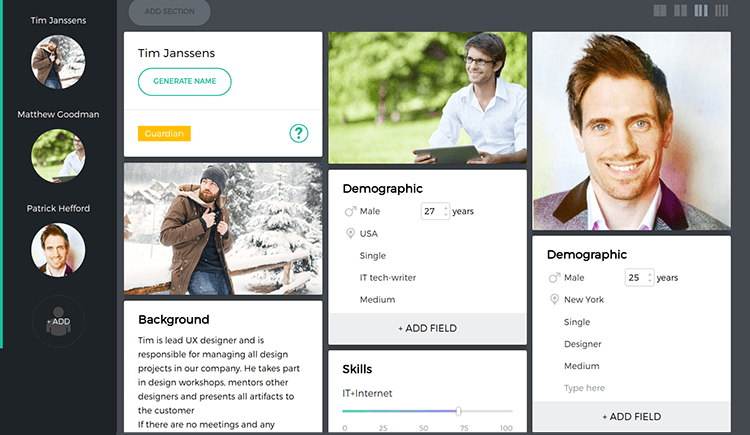By this time, you probably know a lot about personas – what they are, how to create them, and why you want to have them in the first place. It could be that you’ve already persuaded everyone (including your dog) to bring them into your company. It could be that you even tried to create a persona with our fancy tool. But how many personas should you have? One? Five? A dozen? None?! Are there any standards? Let’s tackle these questions together in this post.
The answer is – it depends. Well, this isn’t quite helpful and hardly can be called the answer. See, like it is with touchpoints, there’s no golden standard when it comes to numbers. Unlike touchpoints, the “more is better than less” rule does not apply here. Now we can start working out some ideas based on this.
Persona numbers come from research

First of all, to identify how many personas your company should have, your team will need to do some market research. Conduct a market segmentation to bring out the main groups of your target customers. Then, break these groups into subgroups.
Ideally, what you should end up with is a certain number of customer subgroups each of which has a set of traits and characteristics that unite them.
For example, say you have a coffee house and the target audience is fairly diverse. It can be hardcore coffee lovers who can tell by the smell itself what sort of coffee was used and how exactly the beans were ground. It can be some amateurs who don’t really care about such nuances, but they love the atmosphere of coffeehouses and they enjoy hanging out there with friends. There can be some in-a-hurry folks who just need that espresso shot to keep them going.
You need to describe these groups precisely enough so you can transform them into personas. Don’t spend too much time working on details, though. At the same time, do not try to cut corners. Your subgroups shouldn’t be very broad. So you need some sort of a happy medium.
No numbers? No problems!
It can happen so that your management won’t allocate the resources needed until you prove that using this artifact is well-worth all the expenses. If this is the case, ad-hoc personas are your go-to option.
In this wonderful book called Persona Lifecycle, ad-hoc (or proto) personas are defined as persona sketches that your team can create to articulate your organization’s existing assumptions about the user population.
As it comes from the definition, proto-personas are non-research-backed and based completely on assumptions your team has about the users. Proto-personas are used to help you communicate the need for personas to stakeholders as well as to have some practice before you get to creating real personas.
But we’re here for numbers, right? Guess what! You can use assumptions to segment the market and decide on the number of customer groups. It doesn’t mean, however, that you won’t need a full research at all. It does mean that you’ll need to do it a bit later.
Define personas

Once you’re done with customer group segmentation, you finally get to figuring out how many personas you need.
And here’s a trick: you want to keep this number to a minimum. Ideally, there have to be as many personas as there are subgroups. But if your business is, say, food retail, your customer population is extremely diverse and there can be a whole lot of subgroups. In such a case, it wouldn’t be so wrong to zoom out a little and merge some subgroups into larger ones.
Wait, but why? Well, the reason for greed here is that personas require a lot of maintenance. They have to be constantly iterated and updated. If you have an army of them, any tiny change will result in hours of work and I cannot say that this work is necessary.
I believe that the size of your persona pack should be around the average family size. And that’s around 3 to 5 give or take. This number will suffice business needs in most cases.
Of course, your case can be very different and you may end up with an absolutely different number of personas. To help you find it, I suggest you answer the following questions offered in the Persona Lifecycle book:
- How many personas do I need? This goes back to our research and market segmentation.
- Which personas do I need? Chances are, some groups will turn out to be not worth designing for. Either because they’re too small or too specific. So you drop them.
- Which personas should I make primary or secondary? Here, you can decide based on which group is the biggest or the most important in terms of profits.
- How do I use secondary personas without designing for everyone? And it’s all about zooming out and keeping personas to a minimum.
Remember that personas must be inspiring and they must be relevant to your product and business goals. So keep the ones that meet these requirements and get rid of those that don’t.
We hope this helps you answer this difficult question and find the optimal number of personas to create. And once you find it, don’t forget to use UXPressia Personas Tool to bring personas from ideas in your teammates’ minds to the real world!






